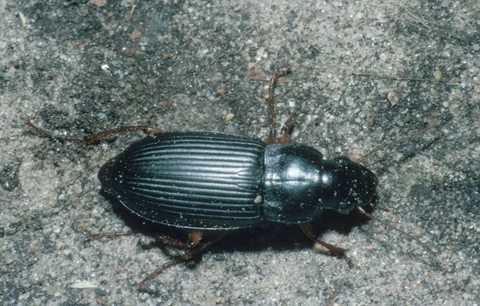Quick facts
Ground beetles are one of the most common groups of beetles in North America.
- They are found in many types of environments including forests, fields, shorelines and agriculture.
- They are also found in landscapes and around homes, especially in August.
- They may sometimes, become a nuisance inside buildings.
- Outdoors, ground beetles are considered beneficial as they feed on other insects.
How to identify ground beetles
Most ground beetles are small to moderate-sized insects.
- About 1/8 to 1/2 inches long (a few can become as large as 1 inch in length).
- They are generally flattened insects with obvious mandibles (jaws).
- Most are black or brown and iridescent (show different colors in different angles of light).
- Some species can be brightly colored, including blues, greens and reds.
- The head is narrower than the neck and has moderate-length, thread-like antennae.
- Ground beetles have long, slender legs.
Behavior and habits of ground beetles
- Outdoors, ground beetles are considered beneficial as they feed on other insects.
- Ground beetles are active at night and sometimes are attracted to lights.
- They hide during the day and are found on the ground under leaves, logs, stones, loose bark and in grassy areas.
- When exposed, ground beetles move quickly to find shelter but rarely fly.
- Most ground beetles feed on other insects as well as other invertebrate animals.
- You can find ground beetles during spring and summer and into the fall.
- Ground beetles usually enter homes in mid and late summer.
- They enter buildings through cracks, spaces and other small openings.
- Inside, they can be found in hidden, damp areas in the basement or under boxes or other objects on the floor.
Ground beetles are not harmful
- Ground beetles do not damage buildings, food or clothing.
- They are not harmful to people.
- If they are mishandled, they could pinch the skin.
- They are just a nuisance when they are found indoors.
- Ground beetles are short-lived indoors and do not reproduce there.
How to control ground beetles indoors
Only a small number of ground beetles are generally seen indoors.
- You can remove them physically, e.g. capture them in a container or remove them with a vacuum.
- You could also try setting out sticky traps, such as those used for cockroaches.
- Place these traps in areas where ground beetles are most commonly found, especially along walls.
If you see a large number of ground beetles, you can reduce them using non-chemical steps:
- Seal and repair potential entry points, such as cracks in the foundation, gaps and spaces around doors, ground-level windows and similar areas.
- Thin out or remove wood mulch or other organic mulch that is directly adjacent to the foundation.
- Stack firewood away from the home as far as is practical.
- Remove stones, leaves, boards and other nearby debris.
- Cut or remove tall grass and weeds around the home.
- Minimize the use of lighting immediately next to the structure or switch the lights from bright white to yellow to minimize attracting ground beetles.
Using pesticides
Pesticides are not necessary if only a few ground beetles are found indoors. When large numbers are getting inside buildings, a pesticide treatment around the exterior of homes is an option.
- Apply a pesticide around the foundation to reduce the number of ground beetles that may enter buildings.
- Common examples of active ingredients are bifenthrin, cyfluthrin, deltamethrin and permethrin.
- These can be purchased as a ready-to-use liquid or as a ready-to-use granular.
CAUTION: Mention of a pesticide or use of a pesticide label is for educational purposes only. Always follow the pesticide label directions attached to the pesticide container you are using. Remember, the label is the law.
Reviewed in 2024





